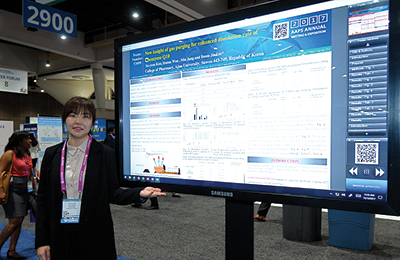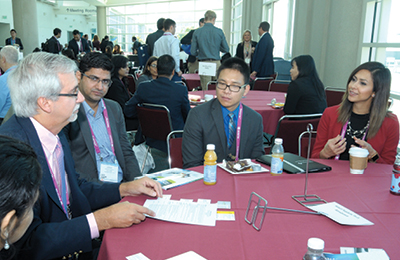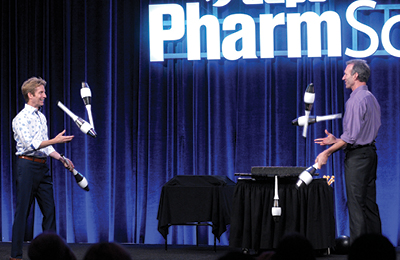Science sessions highlighted regenerative engineering, pediatric research policies, nanomedicine regulations, and CAR-T therapies.
By Lynne Friedmann
The past quarter century has witnessed an array of discoveries and new approaches that have dramatically advanced the independent fields of developmental biology, materials science, physics, stem-cell research, and clinical translation. Furthermore, a convergence of these disciplines has created an entirely new field: regenerative engineering, which has as its central goal the development of scalable tools for the regeneration or reconstruction of complex tissue and organs.

Advances in this multidisciplinary endeavor were the focus of a pioneer in this emerging field: Cato Laurencin, M.D., Ph.D., whose keynote address Solving Problems with Regenerative Engineering marked the opening of the 2017 American Association of Pharmaceutical Scientists’ (AAPS) Annual Meeting and Exposition held November 12–15, in San Diego.
An orthopedic surgeon and engineer, Laurencin is the founding director of the Institute for Regenerative Engineering at the University of Connecticut, where a range of basic and translational research initiatives are under way. One example is musculoskeletal tissue engineering which includes bone, tendon, ligament, cartilage, meniscus, and muscle.
“When we first talked about regenerating bone, people said it couldn’t be done,” said Laurencin.
By varying the hydroxyapatite concentration and stirring time in polymer ceramic materials, good mechanical properties and cortical bone levels have been achieved.
Laurencin became intrigued by the properties of nanoscale technology and published the first paper showing the suitability of polymer nanofiber structures for regeneration of tissues.
“Nanoscale is important because increased surface-area-to-volume ratio provides more sites of adhesion for proteins,” he said.
Ongoing work, comparing different scaffold materials in the muscle pouch of mice, shows more bone generated when using a nanofiber matrix. However, implanting a nanofiber matrix in weight-bearing areas has not worked because of lack of the mechanical properties needed to allow regeneration to occur. The team’s solution was to combine a composite microsphere matrix with nanofibers to create a micro-nano matrix in which nanofibers occupy what otherwise would be void space.
“This micro-nano matrix allows us to get the best of both worlds in terms of having needed mechanical properties while also utilizing the nano regime,” said Laurencin.
Combining advanced materials and stem cells represents another evolution in the field. Laurencin’s group works primarily with adult stem cells derived from fat.
Another area being actively explored is the concept of inductive materials that can allow for the differentiation of different types of stem cells without the use of morphogens.
The audience chuckled when Laurencin quipped: “Sorry about that. I know this is a pharmaceutical meeting.”
THANKS FROM A GRATEFUL PATIENT

In 1978, National Football League player Rolf Benirschke developed symptoms of ulcerative colitis.
About to begin his second season as a placekicker for the San Diego Chargers, Benirschke kept his condition from the team’s front office and his teammates until one day he collapsed aboard a cross-country team flight after a game. Two emergency surgeries within six days were required to repair his perforated colon. Benirschke would spend almost six weeks in the ICU fighting for his life.
“I should have died at age 24,” he said. “I’m alive at 62.”
In his talk, Thanks from a Grateful Patient, Benirschke credits dramatic medical and pharmaceutical advances for his survival and ability to return to the gridiron—the first active NFL player to wear an ostomy appliance—to play seven more seasons with the Chargers.
“The reason you do this is for people like me,” he said of pharmaceutical research.
Years later, Bernirschke would need to draw upon cutting-edge research once again after learning he had become infected with hepatitis C virus harbored within the nearly 80 units of blood given to him during his life-saving surgeries.
Bernirschke would ultimately participate in three year-long clinical trials over an eight-year period, including early trials of interferon. The daily injection regime left him constantly listless with flu-like side effects; they also didn’t clear the virus. But Benirschke maintained hope, and with each trial, therapies improved. In 2004, his hepatitis C was cured.
“I am the biggest proponent of pharma,” he said.
Bernirschke cofounded Legacy Health Strategies (www.legacyhealthstrategies .com) in 2009. One of the first companies to offer patient engagement with pharma, Legacy Health Strategies has supported thousands of patients in numerous disease states by partnering with medical device, pharmaceutical, and clinical trial organizations.
PEDIATRIC RESEARCH POLICIES IN THE U.S.
A 1997 Food and Drug Administration (FDA) survey of medication labels revealed upwards of 80 percent lacked dosing information for children; only 20 percent to 30 percent of approved drugs were labeled for pediatric use; and only 38 percent of new drugs potentially useful in pediatrics were labeled for children when initially approved.
 Shortly thereafter, the U.S. Congress began enacting policies to facilitate pediatric research in drugs and biologics to better address the needs of sick children. Twenty years later, 700 labeled products with useful pediatric prescribing information to appropriately treat children have been developed and brought to market. But pediatric research still remains fraught with challenges.
Shortly thereafter, the U.S. Congress began enacting policies to facilitate pediatric research in drugs and biologics to better address the needs of sick children. Twenty years later, 700 labeled products with useful pediatric prescribing information to appropriately treat children have been developed and brought to market. But pediatric research still remains fraught with challenges.
“It generally takes many times longer to recruit and complete a pediatric study,” said Chin Koerner, Ph.D., executive director of U.S. Regulatory Policy for Novartis, in his talk How Do We Facilitate the Development of Safe and Effective Drugs for Children?
Koerner offered a case in point: In an antihypertensive efficacy study involving adults and children, the adult trial enrolled 220 patients in nine U.S. sites (24 patients per site) and took five months to complete. The pediatric trial required 253 patients (ranging in age from 6 to 16 years), 70 sites (3.5 patients per site) in three countries, and took 12 months to complete.
Special considerations in pediatric study design and conduct include the need for several age subsets; fewer pediatric patients available for recruitment; special facilities, equipment, nurses, laboratories, and expertise for dealing with young children; and because subjects are too young to give informed consent, parents and even grandparents making decisions.
“You may enroll only the child, but the entire family is involved,” said Koerner.
Regulators have addressed pediatric issues with
the Pediatric Research Equity Act, which requires pharma companies to test in pediatric population any new drugs likely to be used in children;
the Best Pharmaceuticals for Children Act that provides incentives for voluntary studies such as granting an additional six months of marketing exclusivity; and
the 2012 Creating Hope Act: Pediatric Rare Disease Priority Review Voucher program, which rewards sponsors who develop new drugs for a predominately pediatric rare disease with a Priority Review Voucher (PRV) that allows a review in six months of a future application. So far, 11 PRVs have been issued for novel therapies for pediatric rare diseases. Furthermore, PRVs are transferrable (including by sale).
“The highest sale price to date for a PRV is $350 million,” said Koerner.
NEW GENERATION OF NANOMEDICINE: SCIENTIFIC AND REGULATORY CHALLENGES
Prognosticators of the future of health care envision nanomedicines assuming a prominent role that may eventually overtake conventional and personalized medicine. First-generation nanomedicines have shown success in recent decades, but are new efforts becoming too complicated with respect to structure and function?
“What has gone to clinic? Things that were simple not complex,” said Vinod Labhasetwar, Ph.D., in his talk Simple Is Better in Nanomedicine.
 Labhasetwar, director of the Cancer Nanomedicine Program at the Cleveland Clinic, cited as examples non-PEGylated liposomes, PEGylated liposomes, micelles, nanoparticles, and targeted nanocarriers.
Labhasetwar, director of the Cancer Nanomedicine Program at the Cleveland Clinic, cited as examples non-PEGylated liposomes, PEGylated liposomes, micelles, nanoparticles, and targeted nanocarriers.
Complexity arises when attempts are made to place multiple drugs and different stimulating agents on nanostructures. At the same time, the ability of engineers to create different nanostructure shapes, compartments, striations, and architectures only adds to the challenge.
“We’re going forward at a faster pace without thinking whether we can really use these types of systems,” said Labhasetwar.
In Commercializing Nanomedicine—Industrial Perspective, Greg Troiano, M.S., vice president of Nanomedicine Development and Manufacturing at Pfizer Inc., observed: “The amount of work in the research-and-discovery space in nanotechnology for our field has exploded. But it’s fair to say the number of products is not commensurate with the level of effort.”
Between 1970 and 2015, a total of 359 applications (investigational new drug, new drug, and abbreviated new drug) for drug products containing nanomaterials were submitted to FDA’s Center for Drug Evaluation and Research.
FDA recognizes nanotechnology as an emerging technology increasingly used in products regulated by the agency (e.g., drugs, medical devices, cosmetics, combination products, and dietary supplements.)
“While existing FDA regulatory framework is sufficient for current nanotechnology platforms, it may continue to evolve as the technology and its use changes their direction in future,” said Akm Khairuzzaman, Ph.D., acting branch chief, Office of Pharmaceutical Quality at FDA.
The agency currently grapples with non-standardization of nomenclature, test methods, and characterization of nanotechnology. Consider this: There are different American, Canadian, and European definitions for something as basic as what constitutes nanoscale.
At the forefront of the drive for clinically relevant specifications and international standards is the American Society for Testing and Materials Committee E56 on Nanotechnology (www.astm.org/COM MITTEE/E56), which has a subcommittee on medical products specifically to address issues related to standards and methods to characterize nanomaterials.
“I encourage you to get involved in this standardization committee,” said Khairuzzaman.
DELIVERY OF NUCLEOTIDE BASED DRUGS—ARE WE GOING TOO FAST?
Lipid nanoparticles (LNPs) offer an efficient way to stabilize mRNA for intracellular delivery. However, a cell’s reaction to nanomedicines can be the same as when detecting viral mRNA: Activate an immune response.
This and other safety concerns of LNPs nanotechnology were the focus of Delivering on the Promise of mRNA Therapeutics Safety and without Complement by Joseph Senn, Ph.D., head of Nonclinical Sciences at Moderna Therapeutics, founded on the concept of modifying mRNA-specific uridine residues to decrease its interactions with intercellular sensors.
 “With administration of unmodified nucleotides, we get a pronounced activation and expression of interferon alpha indicating antiviral or toll-like receptor pathways have been triggered,” he said.
“With administration of unmodified nucleotides, we get a pronounced activation and expression of interferon alpha indicating antiviral or toll-like receptor pathways have been triggered,” he said.
Uridine drives not only immune activation but also IgM-accelerated blood clearance of mRNA drugs such that by the third dose an mRNA drug is rapidly cleared.
“Modified uridines allow for reproducible pharmacology upon repeat dosing,” said Senn. This is because the shape of modified uridine prevents it from locking into and activating immune receptors that detect the presence of foreign RNA.
In his talk, Overcoming Critical Barriers to Lipid-Based Gene Delivery, Tom Anchordoquy, Ph.D., professor, Department of Pharmacology, University of Colorado, cited a review showing current technology achieves only a 1 percent therapeutic dose delivery into tumor models.
“Ninety-nine percent of what we’re injecting doesn’t get where we want it,” he said. “We need to make sure that doesn’t cause a problem elsewhere in the body.”
Among numerous factors unintentionally circulating in the bloodstream is polyethylene gycol (PEG), and this has Anchordoquy concerned.
“You can use PEG to prevent some interactions, but if you’re trying to deliver to those same cells, PEG just gets in the way,” he said.
Anchordoquy also pointed out that PEG is not confined to therapeutics. It is used as a food additive and in a wide range of cosmetics, lotions, and even laxatives.
“We are constantly dosing ourselves with PEG,” he said. “About 30 percent of us have anti-PEG antibodies even though we’ve never had a PEGylated therapeutic.”
Another adverse immune effect from nanoparticles is a rise of hypersensitivity reactions. These reactions can appear within minutes and can last for hours, weeks, or months. Data suggests that both the LNP and nucleic acid (NA) components of LNP-NA contribute to reactogenicity.
How hypersensitivity, inflammatory reactions, and immunogenicity can be studied in large and small animal models (mouse, rat, and pig) was the focus of Immune Barriers of mRNA Therapeutics: Animal Models by Janos Szebeni, M.D., Ph.D., professor of immune biology at Semmelweis University (Hungary) and founder of SeroScience Ltd.
Rats and mice are not particularly sensitive models for these studies. While dog displays sensitivity, it is inconsistent. Rat is sensitive, but mouse less so and is not advised as an in vivo model. Szebeni considers the pig a model of a “super-sensitive human,” making it uniquely applicable as a toxicology model for preclinical evaluation of the risk of hypersensitivity reactions.
MATERIAL CHARACTERIZATION APPROACHES TO ACCELERATE LOCALLY ACTING DRUG PRODUCTS
Among the many challenges facing the design of inhaled formulations for drug delivery is evolution that led to the oropharynx and ciliated upper airways to keep particles from cave fires and savannah dust out of our hominid ancestors’ lungs. Today, it is the job of the particle engineer to bypass those defense mechanisms.
“Lung deposition of a drug depends on aerodynamic particle size,” said Dan Miller, Ph.D., director of Pharmaceutical Development at University of Wisconsin, Madison, in his talk Advanced Characterization Approaches for Inhaled Formulations. “Therefore, the name of the game is to reduce particle size.”
 In addition to size, particles of low density (typically < 0.1 g/cm3) are desirable for high-efficiency delivery to the lungs. It is a strategy borrowed from nature in the dispersal of spores and pollen.
In addition to size, particles of low density (typically < 0.1 g/cm3) are desirable for high-efficiency delivery to the lungs. It is a strategy borrowed from nature in the dispersal of spores and pollen.
Most dry powder inhalant products on the market are lactose blends of coated crystalline small molecules.
“If you design the right powder—one that fluidizes and disperses at low energy—you can make a simpler device,” he said. “If a device is simpler for patients to use, they are more adherent to their medication.”
For these reasons, Miller believes that engineered particles are the future of the industry.
“One way I look at characterization of engineered particles is it’s another solid dosage form,” he said. “Those of you who work on tablets, our lives are quite similar.”
When it comes to topical formulations, product characteristics include pH, particle size, polymorphism, rheological studies, globule size, and dissolved/undissolved drug.
The quality attribute of highest interest is the pH of a product because it influences the extent of ionization of weakly acidic and basic active pharmaceutical ingredients in formulation.
“The ideal is an unionized drug, because it will absorb better than an ionized form,” said S. Narasimha Murthy, Ph.D., professor of pharmaceuticals, University of Mississippi, in his presentation: Advanced Characterization Approaches for Topical Formulations.
Factors that can change pH in a formulation include interaction with packaging material, loss of contents due to a package leak, or changes in an excipient. The buffer capacity of skin can also change the pH of a product, trying to bring it into homeostasis after application on the skin.
Sensorial characteristics also need to be taken into consideration in product design. Among them: color, appearance, texture, odor, and skin cooling (which occurs within 20 seconds after product application).
Murthy’s group has validated a method using an infrared thermal camera to measure within seconds the drop in skin temperature. In one test, several different cosmetic creams with the same composition, except for a fatty alcohol, were evaluated. A surprising finding was myristyl alcohol imparted a greater skin cooling effect and can replace menthol in certain formulations.
CAR-T INNOVATION—BEGINNING A NEW ERA IN DRUG DEVELOPMENT
The pharmaceutical industry remains abuzz over FDA approval of two Chimeric Antigen Receptor T-Cell (CAR-T) therapies in a single year. First was Kymriah (tisagenlecleucel), from Novartis, for treatment of B-cell precursor acute lymphoblastic leukemia in pediatric patients and young adults up to age 25. Less than two months later Yescarta (axicabtagene ciloleucel), from Kite Inc., received approval to treat diffuse large B-cell lymphoma in adults.
“Just five years from first human trial to approval,” said Abhijit Chakraborty, Ph.D., executive director at Novartis in his hot topic presentation: CAR-T Overview and Regulatory History.
The pace has not slowed down when you consider that in 1997–98 there were one or two CAR-T clinical trials. That number jumped in 2016, with 62 new trials in the U.S. Today, CAR-T is a global undertaking with nearly 200 clinical studies under way in the U.S., Europe, China, and Japan.
 Kymriah (CTL019) is a cell-surface protein expressed in both malignant and healthy B cells but not expressed on bone marrow stem cells or other tissues. It is an autologous product with peripheral blood mononuclear cells containing lymphocytes collected for transduction and expansion a month before therapy.
Kymriah (CTL019) is a cell-surface protein expressed in both malignant and healthy B cells but not expressed on bone marrow stem cells or other tissues. It is an autologous product with peripheral blood mononuclear cells containing lymphocytes collected for transduction and expansion a month before therapy.
Lamis Eldjerou, M.D., medical director at Novartis Oncology, presented data from key clinical trials that enrolled and treated more than 150 patients with pediatric relapsed refractory leukemia. Primary endpoint was the overall response of complete remission (CR) or complete remission with incomplete bone-marrow remission (CRI) within three months following infusion.
In one trial, 83 percent of infused patients responded (52 out of 63) with the overall remission rate consistent across different age, gender, race, and ethnicity subgroups as well as in patients with high disease burden.
“Importantly, these remissions were deep responses,” said Eldjerou. “They were mRD negative and prolonged.”
At six months of onset of remission, 75 percent of the 52 patients who achieved CR or CRI remained in remission.
Regarding safety, Kymriah carries a boxed warning about cytokine release syndrome (CRS) risk and neurological toxicities with the majority of adverse events observed within eight weeks of infusion.
“The safety profile is well profiled and manageable with proper training,” Eldjerou said.
Turning to patient-specific characteristics and clinical outcomes as they relate to the expansion and persistence of cells was Karen Thudium Mueller, Pharm. D, M.S., clinical pharmacologist at Novartis.
“Responding patients have a higher expansion than nonresponding patients,” she said. “The more striking thing is persistence of the cells in responding patients out to 12 months, but we have reported out to two years.”
Two key aspects also investigated were whether prior transplant and prior lines of therapy had an impact on the expansion of cells.
“We found that prior transplant does not,” she said. “Similarly, the line of prior therapies that patients had does not have an impact on expansion of cells.”
In the management of CRS, one of the main agents used is post-tocilizumab.
“We wanted to confirm that post-tocilizumab is not going to impact the expansion and persistence of cells,” she said. “Neither was affected. This was an important finding.”
Lynne Friedmann is a freelance science writer in the San Diego area. She can be contacted at friedmannlynne@gmail.com.
